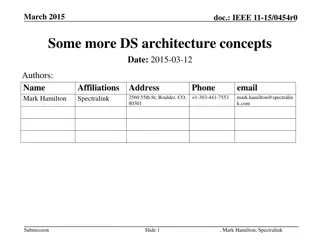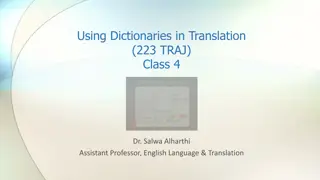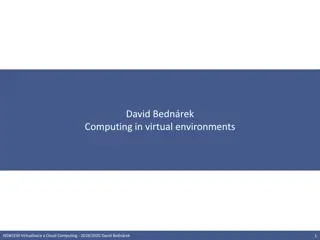Environments,Tuples,& Dictionaries
Explore the concepts of environments, tuples, and dictionaries in Python through visual diagrams and explanations. Learn about how Python interprets programs, assignments, functions, and function calls within different frames and environments. Discover the rules for name lookup in user-defined functions and gain insights into the Python evaluation process.
Download Presentation

Please find below an Image/Link to download the presentation.
The content on the website is provided AS IS for your information and personal use only. It may not be sold, licensed, or shared on other websites without obtaining consent from the author.If you encounter any issues during the download, it is possible that the publisher has removed the file from their server.
You are allowed to download the files provided on this website for personal or commercial use, subject to the condition that they are used lawfully. All files are the property of their respective owners.
The content on the website is provided AS IS for your information and personal use only. It may not be sold, licensed, or shared on other websites without obtaining consent from the author.
E N D
Presentation Transcript
Environments, Tuples, & Dictionaries
Environment Diagrams An environment diagram is a visualization of how Python interprets a program. Use the free website PythonTutor to generate diagrams. View example Code (left) Frames (right) Arrows indicate the order of execution. Green = just executed, red = up next. Each name is bound to a value. Within a frame, each name cannot be repeated.
Assignments in Environment diagrams How Python interprets an assignment statement: Evaluate the expression to the right of =. Bind the expression's value to the name that's on the left side of the = sign. View in PythonTutor
Functions in environment diagrams How Python interprets a def statement: It creates a function with the name and parameters It sets the function body to everything indented after the first line It binds the function name to that function body (similar to an assignment statement) View in PythonTutor
Function calls in environment diagrams How Python interprets a function call: It creates a new frame in the environment It binds the function call's arguments to the parameters in that frame It executes the body of the function in the new frame View in PythonTutor
Names and environments All Python code is evaluated in the context of an environment, which is a sequence of frames. We've seen two possible environments: Global Frame Function's local frame, child of Global frame
Name lookup rules How Python looks up names in a user-defined function: 1. Look it up in the local frame 2. If name isn't in local frame, look it up in the global frame 3. If name isn't in either frame, throw a NameError *This is simplified since we haven't learned all the Python features that complicate the rules.
Name lookup example #1 def exclamify(text): start_exclaim = " " end_exclaim = "!" return start_exclaim + text + end_exclaim exclamify("the snails are eating my lupines") On line 4, which frame is start_exclaim found in? The local frame for exclamify On line 4, Which frame is text found in? The local frame for exclamify On line 6, which frame is exclamify found in? View in PythonTutor The global frame
Name lookup example #2 start_exclaim = " " end_exclaim = " " def exclamify(text): return start_exclaim + text + end_exclaim exclamify("the voles are digging such holes") On line 5, which frame is start_exclaim found in? The global frame On line 5, Which frame is text found in? The local frame for exclamify On line 6, which frame is exclamify found in? View in PythonTutor The global frame
Name lookup example #3 def exclamify(text): end_exclaim = " return start_exclaim + text + end_exclaim " exclamify("the voles are digging such holes") Which name will cause a NameError? The start_exclaim name, since it was never assigned. When will that error happen? It will happen when exclamify is called and Python tries to execute the return statement. View in PythonTutor
Tuples A tuple is an immutable sequence. It's like a list, but no mutation allowed! An empty tuple: empty = () # or empty = tuple() A tuple with multiple elements: conditions = ('rain', 'shine') # or conditions = 'rain', 'shine' A tuple with a single element: oogly = (61,) # or oogly = 61,
Creating a tuple from another sequence Just like the list() function creates a list from an iterable sequence (like a list or string), the tuple() functions creates a tuple from an iterable sequence digit_list = [0,1,2,3,4,5,6,7,8,9] digit_tuple = tuple(digit_list) # (0,1,2,3,4,5,6,7,8,9)
Tuple operations Many of a list's read-only operations work on tuples. Combining tuples into a new tuple: ('come', ' ') + ('or', ' ') # ('come', ' ', 'or', ' ') Checking containment: 'wally' in ('wall-e', 'wallace', 'waldo') # False Accessing elements: conditions = ('rain', 'shine') conditions[1] # 'shine' Slicing: digits = (0,1,2,3,4,5,6,7,8,9) numbers = digits[3:8] # (3,4,5,6,7)
Dictionaries A dict is a mapping of key-value pairs states = { "CA": "California", "DE": "Delaware", "NY": "New York", "TX": "Texas", "WY": "Wyoming" } >>> len(states) 5 >>> "CA" in states True >>> "ZZ" in states False
Dictionary selection words = { "m s": "more", "otro": "other", "agua": "water" } Select a value: >>> words["otro"] 'other' >>> first_word = "agua" >>> words[first_word] 'water' >>> words["pavo"] KeyError: pavo >>> words.get("pavo", " ' ' ")
Dictionary rules A key cannot be a list or dictionary (or any mutable type) All keys in a dictionary are distinct (there can only be one value per key) The values can be any type, however! spiders = { "smeringopus": { "name": "Pale Daddy Long-leg", "length": 7 }, "holocnemus pluchei": { "name": "Marbled cellar spider", "length": (5, 7) } }
Dictionary iteration insects = {"spiders": 8, "centipedes": 100, "bees": 6} for name in insects: print(insects[name]) What will be the order of items? 8 100 6 Keys are iterated over in the order they are first added.
Dictionary comprehensions General syntax {key: value for <name> in <iter exp>} Notice the curly braces {} instead of brackets [] There are two items before the for keyword: the key and the value separated by a colon Example {x: x*x for x in range(3,6)} # {3: 9, 4: 16, 5: 25}
Incremental Program Development There is often the temptation to write large sections of code all at once before testing any of it This is usually a bad idea as we need to search through all the code written to find any bug introduced A better method is to write a little bit of code, test it, then write a bit more Bugs are localized We know we have working code every step of the way
Stepwise Refinement Stepwise refinement is a process that goes hand in hand with incremental development You start by taking a large problem and dividing it into smaller ones You then divide the smaller ones into yet smaller chunks, Repeat this process until you are the point where you are starting to think in terms of code. This is often done on paper (physical or digital) separate from the code. Or you might do it as comments in the code files themselves. These smallest chunks are the perfect size for incremental development Implement one chunk, test it, and move to the next one























